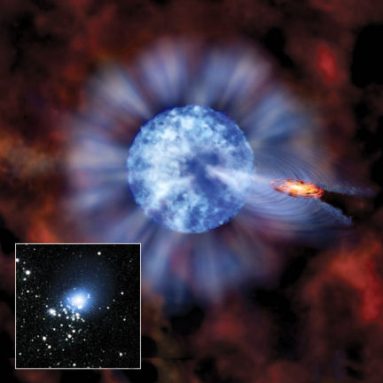Monster Black Holes
Scientists have discovered black holes that are far more massive than they had thought possible.
Share this:
- Share via email (Opens in new window) Email
- Click to share on Facebook (Opens in new window) Facebook
- Click to share on X (Opens in new window) X
- Click to share on Pinterest (Opens in new window) Pinterest
- Click to share on Reddit (Opens in new window) Reddit
- Share to Google Classroom (Opens in new window) Google Classroom
- Click to print (Opens in new window) Print
By Emily Sohn
Black holes have long captured the imaginations of both kids and scientists. These incredibly dense objects cram the mass of huge suns into tiny points of space. The gravity of a black hole is so intense that it sucks in everything around it, including light.
Black holes can form in different ways. One type—called stellar black holes—form after massive stars collapse. Astronomers had thought that these black holes could only hold as much mass as about 10 of our suns.
Now, however, a team has found a stellar black hole with 15.65 times as much mass as the sun. And another team has evidence of an even larger stellar black hole.
 |
|
The large image is an artist’s illustration of a huge star orbiting a massive black hole. The star (the blue object) is 70 times as massive as the sun. The black hole (surrounded by an orange disk) is 15.65 times as massive as the sun. The small image uses a combination of types of light to show the star and the black hole, which live in the nearby galaxy M33.
|
| M. Weiss, CXC, NASA; (Inset) Orosz et al., NASA, STScI |
These black holes form when especially massive stars reach the end of their lives and collapse. The new discoveries may force scientists to reconsider long-held theories about that process.
The first find came from observations of a pair of stars that live close to our galaxy—the Milky Way—in a galaxy called M33. The two stars orbit each other. From Earth, it looks as if they take turns passing in front of each other.
Researchers from San Diego State University figured out that one of the stars is huge—70 times as massive as Earth’s sun. By looking at how long it takes each star to pass in front of the other, the team determined that the smaller of these stars is extremely compact.
The scientists’ calculations showed that the compact star is 15.65 times as massive as our sun. With that much mass, it must be a black hole. In fact, it is the heaviest stellar black hole that has ever been accurately measured. The scientists estimate that the star that produced it was originally 100 times as massive as the sun.
It is hard to explain the pairing of a huge star with a huge black hole using current theories about the life cycles of stars, the researchers say.
For one thing, prior to its collapse into a black hole, the initially larger star should have produced a strong wind that would have blown off much of its mass. Also, earlier in life, this star would have briefly swollen, spilling some of its mass onto its partner. Losing all of that mass could have made it hard for that star to remain massive enough to form a giant black hole.
A second recent discovery is even harder to explain. Researchers from the Harvard-Smithsonian Center for Astrophysics in Cambridge, Mass., studied X-rays coming from a spot in another nearby galaxy called IC 10. The pattern of radiation they observed, these researchers say, most likely comes from the pairing of a bright, heavy star with a more compact object.
On the basis of their observations, the scientists calculated that the compact body is a black hole that is 25 to 34 times as massive as the sun.
The new discoveries suggest that stellar winds drive off much less star mass than researchers used to think they did. The finds also suggest that there may be many unexpectedly huge stellar black holes throughout the universe.—Emily Sohn
Going Deeper:
Cowen, Ron. 2007. Odd couples: Big black holes challenge star theory. Science News 172(Oct. 27):261-262. Available at http://www.sciencenews.org/articles/20071027/fob5.asp .






